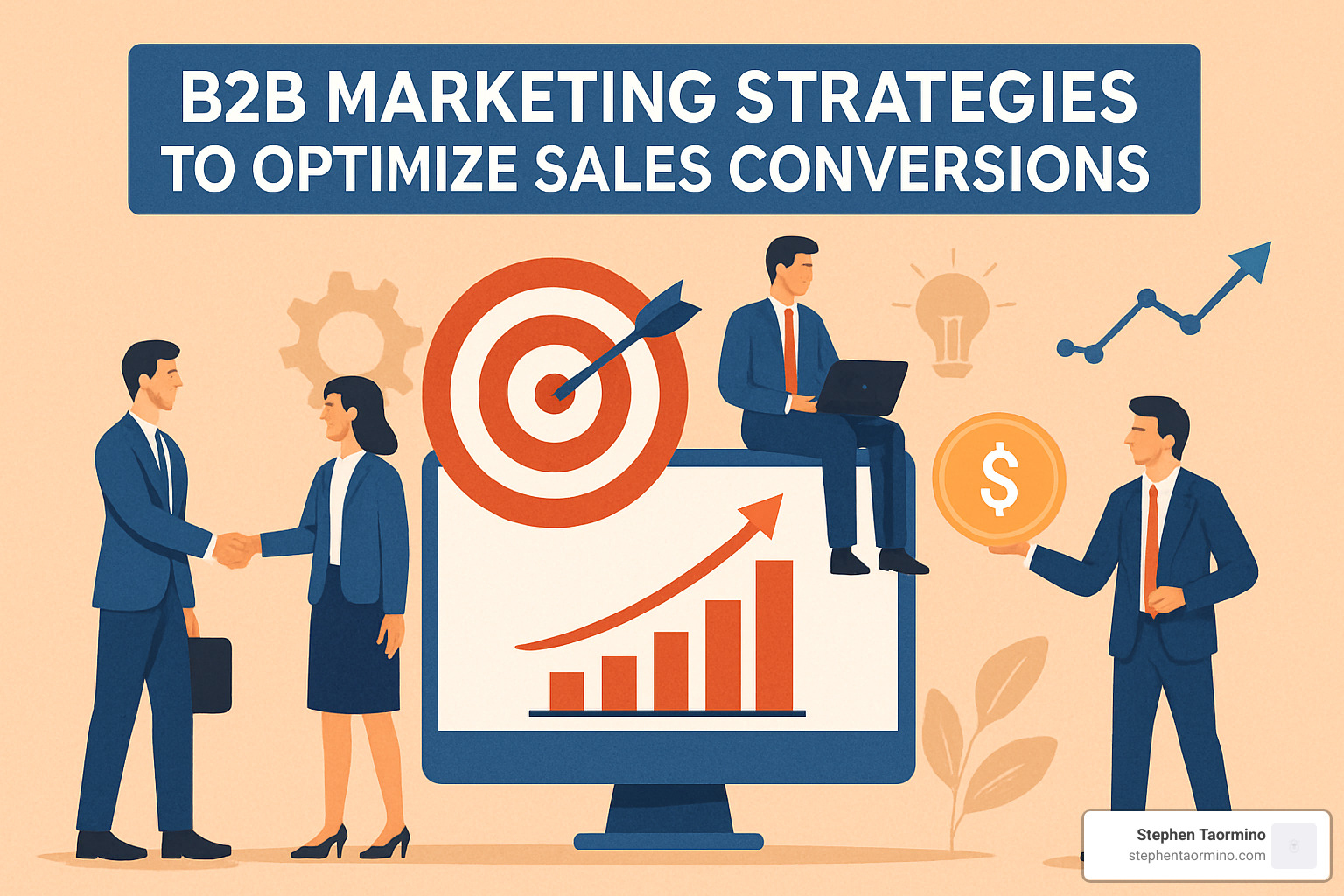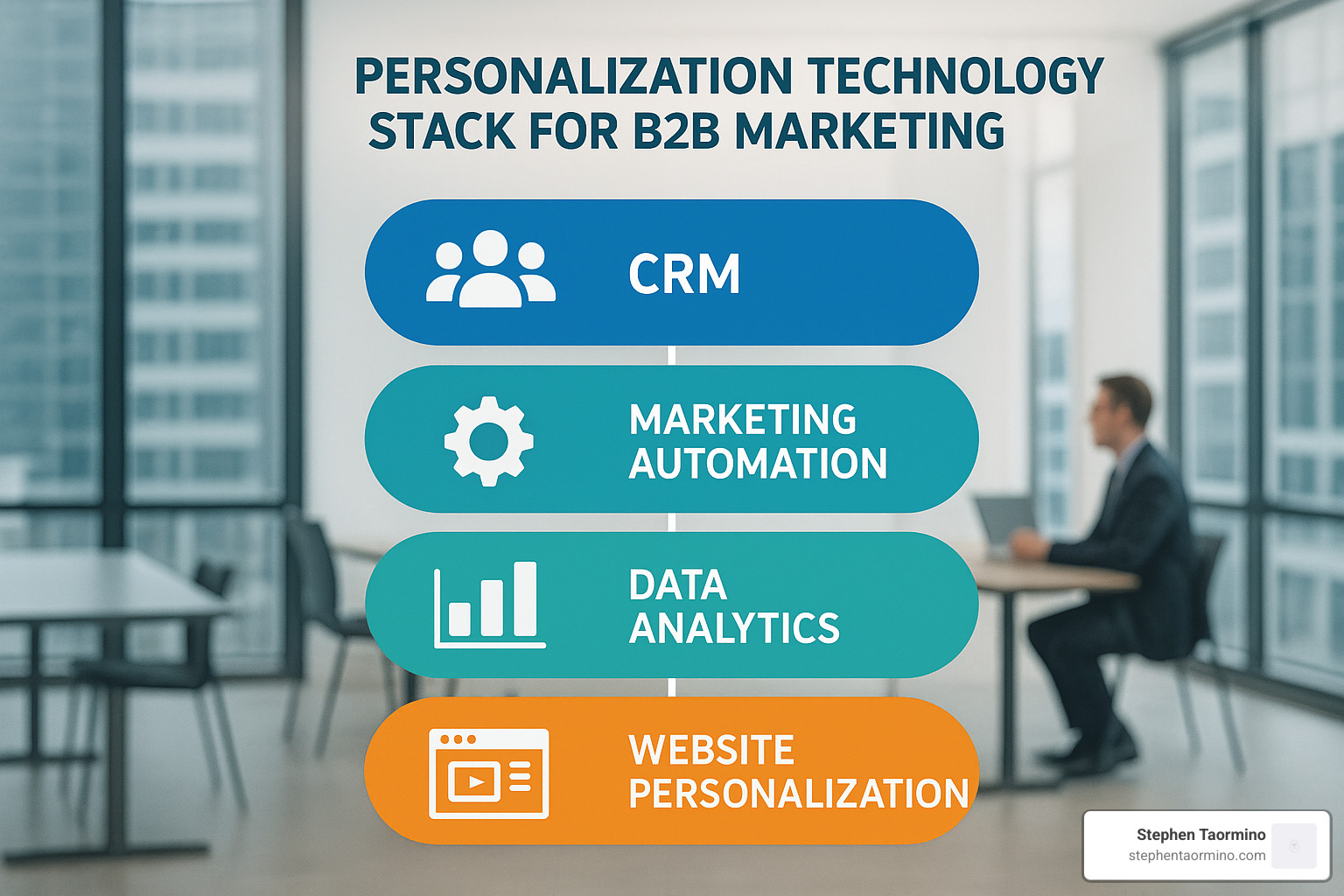Why Modern B2B Conversion Requires a Strategic Approach
B2b marketing strategies to optimize sales conversions are more critical than ever in today’s complex business landscape. Here are the most effective strategies proven to drive results:
Top B2B Conversion Optimization Strategies:
– Map buyer journeys across awareness, consideration, and decision stages
– Build conversion-focused websites with simplified forms and social proof
– Create authority content through case studies, webinars, and thought leadership
– Implement multi-channel nurturing with email sequences and retargeting
– Align sales and marketing using account-based marketing approaches
– Personalize experiences with data-driven psychology and dynamic content
– Continuously test and optimize based on key performance metrics
The modern B2B buying process has fundamentally changed. Today’s buyers conduct an average of 12 searches before engaging with a brand’s website, and 89% of B2B researchers use the internet throughout their decision-making process. With sales cycles often spanning months or years and multiple stakeholders involved in every decision, the old playbook of generic outreach and one-size-fits-all messaging simply doesn’t work anymore.
What makes this challenging is that only 28% of companies are satisfied with their current conversion rates, while 37% report being quite or very dissatisfied with their results. The attention economy demands more than basic lead generation—it requires what I call “marketing magic”: the strategic blend of psychology, technology, and human insight that transforms casual browsers into loyal customers.
I’m Steve Taormino, President & CEO of CC&A Strategic Media, where I’ve spent over 25 years helping organizations worldwide develop b2b marketing strategies to optimize sales conversions through marketing psychology and human behavior insights. My approach combines proven conversion principles with cutting-edge technology to create systematic processes that turn prospects into profitable long-term relationships.

B2B Sales Conversion Optimization 101
B2B conversion optimization is the disciplined process of turning a higher percentage of visitors and leads into paying customers3227without resorting to gimmicks. Because B2B deals involve longer sales cycles, larger price tags, and buying committees, the approach looks very different from B2C CRO.
What Is B2B Conversion Optimization?
Think of the journey as awareness ��� consideration ��� decision ��� delight.
1. Attract strangers with valuable content and SEO.
2. Convert visitors into leads using clear offers and friction-free forms.
3. Nurture those leads with personalized emails, retargeting, and sales conversations.
4. Delight customers so they become promoters and case-study material.
Companies with formal sales processes generate 28 % more revenue, yet the median B2B site converts only 4.3 % of qualified visitors. Worse, each deal now includes an average of 6.8 decision-makers. That means your message must resonate with finance, IT, and end-users simultaneously.
Why the Buyer Journey Dictates Strategy
Modern buyers finish 60–70 % of their research before talking to sales and perform 12 searches on average before even landing on your site. They expect you to understand their unique needs from the first click. If you don’t provide self-serve information that matches each stage of their journey, they will move on to a competitor—often silently.
Emotions still matter: fear of choosing the wrong vendor, desire for career growth, and social proof from peers all influence decisions. The smartest b2b marketing strategies to optimize sales conversions therefore combine data, empathy, and psychology—not just prettier buttons.
7 High-Impact B2B Marketing Strategies to Optimize Sales Conversions
Below is a streamlined playbook you can execute without drowning in detail. Each tactic works best when integrated with the others.
1. Map the Journey
• Build outcome-focused personas that outline timeline, influencers, content needs, and pain triggers.
• Treat journey maps as living documents you revisit every quarter.
2. Build Conversion-Centered Pages

• Load in <3 s or lose 40 % of traffic.
• Ask only essential form fields; add the rest later via progressive profiling.
• Place testimonials and recognizable logos near CTAs.
3. Leverage Authority Content
• Publish educational posts, industry reports, and short videos that answer real questions.
• Showcase case studies with quantified results.
• Host webinars/podcasts—long-form formats that busy executives can consume while multitasking.
More ideas live in our Videos library.
4. Activate Multi-Channel Nurturing
• Segment email drips by persona and buying stage.
• Use LinkedIn and Google retargeting to stay visible during long evaluations.
• Deploy chatbots/live chat for real-time answers.
Lead nurturing programs yield 45 % higher ROI than one-and-done campaigns.
5. Align Sales & Marketing with ABM
• Create account “battle cards” listing org charts, pains, and recent news.
• Share KPIs and dashboards so both teams chase the same revenue goals.
• Coordinate outreach so prospects experience one cohesive conversation.
6. Personalize With Data & Psychology

• Show dynamic headlines or case studies based on industry or past pages viewed.
• Trigger content when prospects linger on pricing or ROI pages.
• Consult research such as this Harvard paper on emotional decision-making.
7. Measure, Test, Repeat
• Track conversion rate, CPL, CAC, CLV, and pipeline velocity.
• Run A/B tests on headlines, CTAs, and email subject lines.
• Review attribution to double-down on channels that move revenue.
See the latest CRO trends in this industry report.
Metrics That Matter & How to Track Them
Focus on a concise scorecard:
• Site conversion rate – visitors ➜ leads
• Lead-to-opportunity rate – leads ➜ sales-qualified
• Opportunity-to-customer rate – proposals ➜ wins
• CPL, CAC, CLV – judge efficiency and long-term value
• Pipeline velocity – speed x size x win rate
Set goals against industry medians (3–5 % site conversion for most B2B firms) and aim for a 20-30 % improvement in six months. Build dashboards that pull CRM, analytics, and automation data into one view.
Tool Stack Essentials
• CRM (single source of truth)
• Analytics + multi-touch attribution
• Marketing automation with behavior triggers
• Heat-mapping / A/B testing software
Choose tools that integrate smoothly rather than piling on features you won’t use.
Common Challenges & Proven Fixes
| Challenge | Quick Fix |
|---|---|
| Long sales cycles | Create milestone-based nurture sequences (6–12 mo) focused on education, not pitching. |
| Data silos | Share unified dashboards; schedule bi-weekly sales-marketing huddles to review them. |
| Form abandonment | Reduce fields, use multi-step forms, and auto-fill known data. |
| Multi-stakeholder buy-in | Supply role-specific decks and ROI tools your champion can circulate. |
| Referral gap | Automate post-purchase surveys and offer simple, incentivized referral links. |
Remember: every obstacle is rooted in human psychology. Address fears, reduce friction, and keep adding value, and your b2b marketing strategies to optimize sales conversions will thrive.
Frequently Asked Questions about B2B Conversion Strategy
What metrics should I track first?
When you’re just starting with b2b marketing strategies to optimize sales conversions, it’s easy to get overwhelmed by all the data available. I always tell my clients to focus on the fundamentals first—you can’t optimize what you can’t measure effectively.
Start with your website conversion rate—this tells you how well your site turns visitors into leads. Then track your lead-to-opportunity conversion rate, which shows how effectively you’re qualifying and nurturing prospects. Finally, monitor your opportunity-to-customer conversion rate to understand how well your sales process closes deals.
These three metrics give you a clear picture of your entire funnel performance. Once you have these baseline measurements, you can identify where your biggest leaks are happening and focus your optimization efforts where they’ll have the most impact.
How is B2B CRO different from B2C?
This is one of the most important distinctions that many marketers miss. B2B conversion optimization is fundamentally different because you’re dealing with complex decision-making processes that can span months or even years.
Unlike B2C buyers who might impulse-purchase based on emotion, B2B buyers need to justify their decisions to multiple stakeholders. They’re spending company money, not their own, which changes everything about how they evaluate options.
Urgency tactics that work brilliantly in B2C—like countdown timers or “limited time offers”—often backfire in B2B environments. Decision-makers can’t be rushed when they need committee approval and extended evaluation periods. Instead, B2B conversion optimization focuses on building trust, providing comprehensive information, and nurturing relationships over time.
The sales cycles are longer, the transaction values are higher, and multiple people influence every decision. This means your optimization strategy needs to account for different stakeholder priorities and provide value throughout an extended buying journey.
How long until I see measurable results?
I wish I could give you a magic number, but the timeline for B2B conversion optimization results varies significantly depending on what you’re measuring and optimizing.
For website-level improvements—like better headlines, simplified forms, or clearer calls-to-action—you can typically see changes in conversion rates within 30 to 60 days. These are the quick wins that can provide immediate momentum for your optimization efforts.
However, meaningful improvements in overall sales conversion rates usually take 3 to 6 months to materialize. This longer timeline reflects the reality of B2B sales cycles, where prospects might engage with your content today but not make a purchase decision for several months.
The key is implementing systematic measurement from day one. Even if you’re not seeing dramatic results immediately, you’ll be collecting valuable data about what’s working and what isn’t. This data becomes the foundation for continuous improvement and helps you make smarter optimization decisions over time.
Conversion optimization is a marathon, not a sprint. The companies that see the best long-term results are those that commit to ongoing testing and refinement rather than expecting overnight changes.
Conclusion
The journey through effective b2b marketing strategies to optimize sales conversions brings us to a simple truth: success isn’t about complexity—it’s about understanding people. After 25 years of helping organizations transform their marketing performance, I’ve learned that the most powerful conversions happen when we combine genuine human insight with smart technology and relentless optimization.
Think of conversion optimization like tending a garden. You can’t force plants to grow faster by pulling on them, but you can create the right conditions—good soil, proper nutrients, adequate water, and patience. The seven strategies we’ve explored create those optimal conditions for your prospects to naturally progress from curiosity to commitment.
The companies that truly excel don’t try to implement every tactic at once. Instead, they choose the strategies that best fit their audience and market, then execute them with the kind of precision and consistency that builds trust over time. Results-focused mindset means celebrating small wins while keeping your eye on the bigger picture of sustainable growth.
What excites me most about modern B2B marketing is how technology has made personalization and psychological insight more accessible than ever. We can now understand our prospects’ emotional triggers, deliver content that speaks directly to their challenges, and create experiences that feel almost magical in their relevance. Yet the foundation remains fundamentally human—building confidence, fostering meaningful professional relationships, and helping people solve real problems.
At CC&A Strategic Media, we’ve witnessed remarkable changes when organizations accept this single-source-of-truth approach to conversion optimization. Companies that were struggling with 1-2% conversion rates suddenly find themselves achieving 4-6% or higher. Sales cycles that once dragged for months begin moving with purpose and momentum.
The secret isn’t in any single strategy—it’s in the continuous improvement mindset that treats every interaction as an opportunity to learn and optimize. Markets shift, buyer behaviors evolve, and new technologies emerge. The organizations that thrive are those that stay curious, keep testing, and never stop asking, “How can we serve our prospects better?”
You’re not just optimizing conversion rates—you’re building relationships that can span decades. Every form field you remove, every piece of valuable content you create, and every personalized experience you deliver contributes to something larger: a reputation for understanding and genuinely caring about your clients’ success.
Ready to put these insights into action? I’ve seen how these principles can transform B2B marketing performance, and I’m excited to share more advanced techniques with you. For detailed case studies and proven implementation strategies, explore our Sales Strategy Optimization resources where we dive deeper into real-world examples of successful conversion optimization programs.
The magic isn’t in the tactics themselves—it’s in how thoughtfully you apply them to serve the people who need what you offer most.
